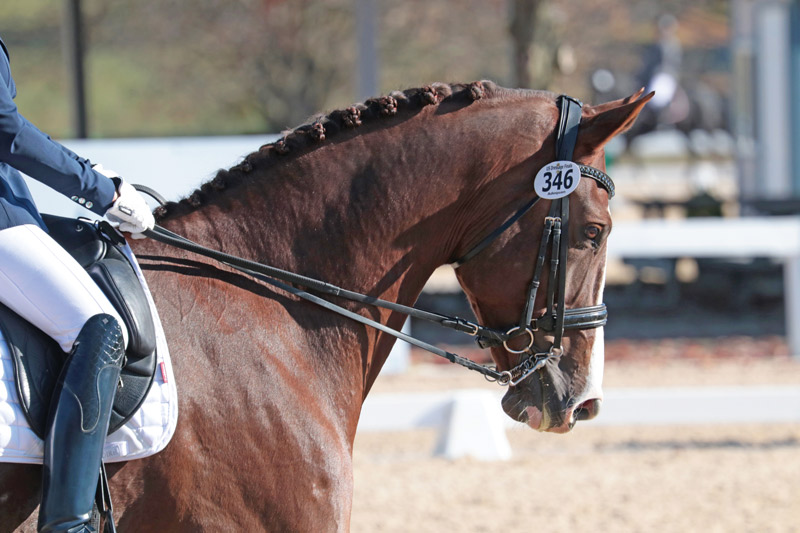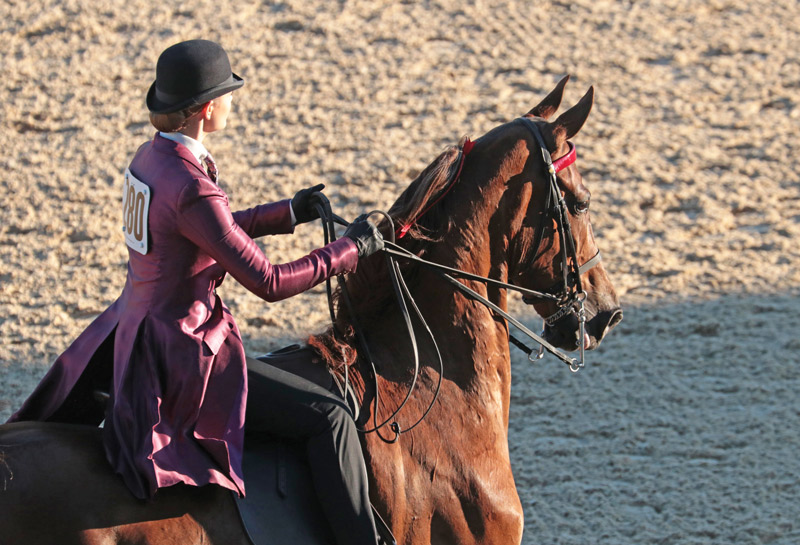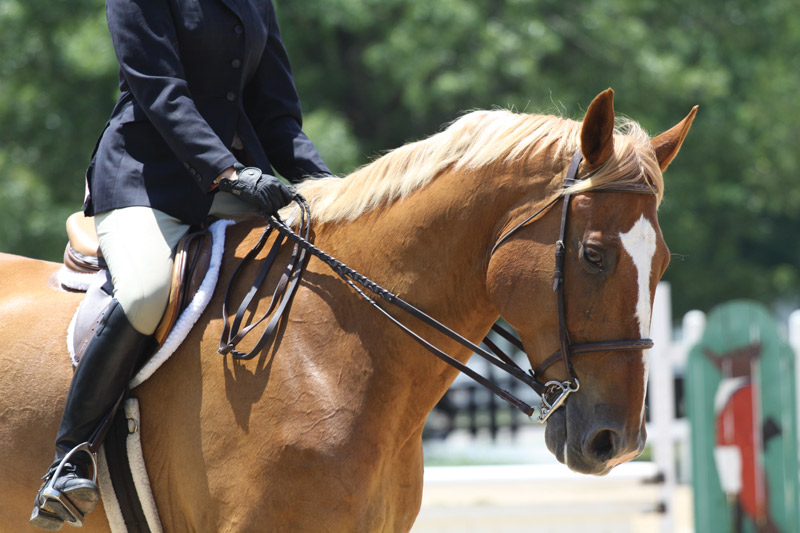
Riders transitioning to the double bridle for dressage or saddle seat classes can find it intimidating at first to handle two reins and two bits and to understand the reins’ actions on both the snaffle and curb.
What Is a Double Bridle?
The double bridle has two bits: a thin snaffle, called a bradoon, and a curb called a Weymouth.
“Each bit has a separate function in the horse’s mouth,” explains Carbonnel.
Using a double bridle requires a certain level of training—in horse and rider—before it’s introduced.
Where Is It Used?
You see the double bridle used in certain disciplines, like saddle seat and upper levels of dressage—usually Third Level and above.
Rules for using a double bridle can vary according to breed and discipline rule books, so consult your association to be sure you’re in compliance with approved use if you’re planning to show with one.
What Is the Function of a Double Bridle?
Let’s start by reviewing the function of the snaffle bit, which is what young horses of all disciplines are normally started in.
“The snaffle is used to aid the rider in establishing a consistent and elastic contact with the horse in the forward movement,” says Carbonnel.
It’s also used to receive and channel the horse’s impulsion when generated from the hindquarters, establish lateral flexion of the neck, and bend through the horse’s body when combined with the seat and leg aids.
The double bridle adds the curb, which is a leverage bit. When combined with the bradoon, the curb functions to raise the neck and stabilize the connection with the hand.
“The curb also helps the rider to further balance the horse on his hindquarters without sacrificing thoroughness and the suppleness of the back,” adds Carbonnel.
When Is It Time to Introduce One?
As Carbonnel explains, the curb bit multiplies the strength of the rider’s hand, so it’s essential to introduce it gradually and with tact to avoid destroying the confidence the young horse has developed in his rider’s hand.
“Adding the curb bit of the double bridle is done only when the horse has mastered the various lateral movements designed to supple his body and has begun the process of loading more weight to his hindquarters,” she says.
It’s never a substitute to force a horse into a frame or a certain headset.
Many dressage trainers only use “the double” intermittently once their horses reach the higher levels to make a specific training point, then return to the single snaffle bridle whenever possible, to avoid creating tension in the horse.

How Do You Fit a Double Bridle?
“Two bits is a lot of metal in the horse’s mouth,” says Carbonnel. Riders need to be understanding that this is a big change for the horse. Fitting the bridle and transitioning slowly to the use of the curb are keys to helping the horse accept the double bridle.
First, take time to fit the horse with bits that conform to the shape of his mouth and that aren’t too thick.
“The curb port needs to fit the horse’s palate and tongue, and the bradoon should mimic the snaffle the horse has been training in,” adds Carbonnel.
The bradoon needs to hang in the mouth so that it doesn’t interfere with the curb on the tongue.
“This can be a challenge if the horse has a small mouth,” she says. “If the bradoon is adjusted too high in the mouth to avoid contact with the curb, it puts annoying and distracting pressure on the corners of the mouth and painful pressure on the poll.”
On the other hand, if the curb is placed too low in the mouth, it risks banging on the male horse’s canine teeth. (Mares generally don’t have canine teeth.)
“The horse may then try to alleviate the pain or the pressure of the bit by pulling his tongue back, or lolling it out to the side,” she explains. “Once this habit becomes ingrained, it is nearly impossible to correct.”
The curb chain also needs to be adjusted correctly. If it’s too loose, it will flop and tickle the horse’s chin, plus interfere with the bradoon when the reins are taken up. If it’s too tight—and if the pressure of the rider’s hand is too intense—any small or inadvertent mistake on the rider’s part becomes painful for the horse. Some horses also have sensitive chins, so the chain must be covered in rubber or leather to avoid pinching.
How Do You Hold Double Reins?
There are several ways to hold two reins in each hand. Here’s a common approach.
“As you sit in the saddle, pick up your snaffle rein as if you’re riding in a regular bridle, with the snaffle rein held between your ring finger and pinky finger,” says Carbonnel.
Take some slack out of the reins, but don’t apply pressure.
“Then, reach your hands down and pick up the curb rein between your middle finger and ring finger.”
For the first few rides, leave the curb rein very loose. Ride using the snaffle bit like you normally would—but remember that the bradoon is likely thinner than your regular snaffle and might cause a quicker reaction or different sensation in your horse’s mouth.
After you’re both comfortable with two reins and two bits, pick up the reins and gently spread your hands apart so that the slack is taken out of the curb rein without pulling on the rein. You’ll continue to ride primarily on the snaffle and not use a lot of curb pressure, even when you’re both comfortable riding with two reins.
Step Up to Two Reins
“The double bridle is a tool to be used for increasing the subtlety and finesse of the horse/rider connection, not to be used for bullying the horse into an artificial ’head set,’” says Carbonnel of the transition to the double bridle.
When you’re ready to step up to the double bridle, she suggests finding an experienced trainer who can help with fitting the bridle and teaching proficient use of the reins. Then take your time and enjoy learning this new journey with your horse!
This article about how to use a double bridle and double reins appeared in the November/December 2020 issue of Horse Illustrated magazine. Click here to subscribe!






